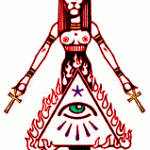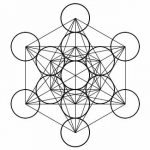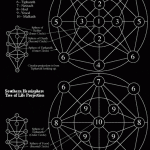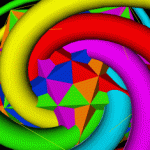by Lady Sekhmet
I spent most of 1996 and 1997 working on recreating illustrations for a book on the physics of consciousness. It promised to be a remarkable work–relating the language of emotion to science and to geometrical principles. To be able to accomplish my task, I learned the principles of sacred geometry. Only after I completed my part did I discover the book would not be published and would never be published. For a long time, I stewed in anger, frustration, and disappointment. I was never paid for my efforts.
Sekhmet comforted me. She indicated that all was not lost. The gift was in the doing. Did I not gain the secrets of sacred geometry? By going through the entire process of drawing fundamental shapes and relating them to universal concepts, did I not now comprehend everything the author was trying to impart and in fact create images with more precision, more clarity, and more beauty than the author’s originals?
So it was in September of 1998 that Sekhmet inspired me to create an image of Her based upon the double square. My process appears below:
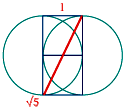
The Square root of five (5) derives from the vesica piscis, a symbol of the fusion of opposites. It is defined by the interlap of two circles at the center.
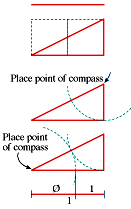
To divide any line at its golden mean, construct a double square upon it. Draw a line from the lower left corner of the first square to theupper right corner of the right square, making a triangle.
Place compass point as shown and open it to the apex of the right angle at the bottom. Swing the compass until it passes the diagonal.
Open the compass to the point just made. Swing the compass downward to see it cross the original line at its golden mean balance.

Upper circle will be Sekhmet’s Celestial orb
1. Geometry showing the square root of five… the beginning point of our drawing.
2. We need to determine a phi (Ø) relationship within each square. Method is shown at right.
Lower circle will be Sekhmet’s face
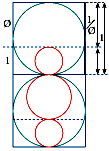
The Golden Section represents the most reduced relationship through which unity may be expressed in proportional form.
3. When the phi (Ø) relationship within each square has been determined, draw circles in relationship to the phi divisions.

4. Working on Sekhmet’s head, divide the upper circle into quarters, the lower circle in half. Then mark off each half of the upper horizontal line into thirds.Extend the two lines closest to the center a little above the horizontal line.

5. Extend the lines mentioned above to the lower boundary of the upper circle. Then make an “X” by extending each to the other side, ending at the horizontal line which divides the lower circle in half.

6. Base the size of the ears on the double square. At this point, you are free to begin diverging from the compass to be more loose when sketching in the lioness’ features–the eyes, nose, and muzzle.

7. When working on the proportions of the cobra, divide the phi circle in half and fit two circles vertically within. Divide the upper smaller circle horizontally and repeat the process. The head of the cobra is created by the upper boundary of the smaller circles.
8. Add the details. Sketch in the mane behind ears and on either side

TIPS: Draw eyelids coming off original horizontal line. Let them curve in and connect with the nose. There are two approaches when drawing the eyes. One is to make a circle, then cut off the top with the brow line followed by the corner lines. Or you can draw the brow line and the inside corner line, then fit in the circle.
Have Fun. Many differing lion faces can be drawn using this template.
Immediately after I had finished figuring out this geometry, an opportunity suddenly appeared to have it manifest itself in 3-D. My next story–of the creation of the Sekhmet Pendant–is a story about how Sekhmet works through the action of synchronicity.
More Articles from Sangraal.com:
Submit your review | |

